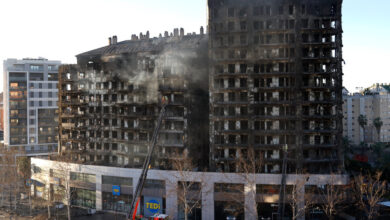
[ad_1]
Violence erupted across Ecuador this week after a well-known gang leader disappeared from prison. Explosions, looting, gunfire and burning vehicles were reported, and there were uprisings in several prisons. In the largest city, Guayaquil, gunmen stormed a TV studio during a live broadcast on Tuesday.
President Daniel Noboa declared a 60-day state of emergency, imposing a nationwide curfew and authorizing the military to patrol the streets and take control of prisons. Mr. Noboa also deployed thousands of police officers and military personnel to search for the gang leader, Adolfo Macías.
Here is what we know so far:
What is the latest?
By Tuesday, violence in Guayaquil had left at least eight people dead, Mayor Aquiles Álvarez said at a news conference. Shops, schools and government offices were closed, and streets in Guayaquil and the capital, Quito, were jammed with traffic as workers tried to get home.
The authorities said that a second major gang leader had escaped from an Ecuadorean prison, along with other inmates. In a presidential decree, Mr. Noboa declared that an internal armed conflict was underway and ordered the military to “neutralize” two dozen gangs, which he called terrorist organizations.
What happened at the TV station?
During a live news broadcast by TC Televisión in Guayaquil, several masked gunmen stormed the set. They forced staff members to the ground, kicking and hitting them. Anchors and other staff were forced to appear in a video asking the president not to intervene.
One of the attackers could be heard saying that he wanted to send a message about the consequences of “messing with the mafias.” But the police moved in before he could be wired up with a microphone.
The police later said they had arrested 13 people, confiscating weapons and explosives, and that all the people who had been taken hostage were safe.
Who is Adolfo Macías?
Mr. Macías, better known as “Fito,” is one of the country’s most notorious kingpins. He is the head of Los Choneros, which is believed to have been one of the first Ecuadorean gangs to forge ties with Mexican drug cartels.
On Sunday, during a sweep for contraband, he was found to be missing from his cell in a crowded prison in Guayaquil, where he had been serving a 34-year sentence for drug trafficking and other crimes. He had escaped prison once before, in 2013.
Like other gang leaders in Ecuador, Mr. Macías had been running his criminal enterprise from behind bars. Some security experts believe as many as a quarter of the country’s prisons are controlled by gangs.
The government had recently ordered Mr. Macías and other high-profile convicts transferred to a maximum-security facility. Experts said that could have prompted his escape and led to the prison uprisings.
How powerful are gangs in Ecuador?
Gang warfare only began plaguing Ecuador, a country of 18 million, in recent years. Over the past half-decade, foreign drug traffickers have joined forces with gangs like Los Choneros to build a powerful drug trafficking industry across the country, infiltrating the government, extorting businesses and killing Ecuadoreans who try to take them on.
Fernando Villavicencio, a presidential candidate who was assassinated in August, said days before his death that he had received multiple threats from members of Los Choneros. He had been outspoken about links between organized crime and government officials.
Mr. Macías was moved to a maximum-security wing after the assassination, but his lawyers successfully argued to have him returned to the cell from which he had been running Los Choneros. Mr. Macías celebrated by releasing a music video.
Mr. Noboa, who won the election and took office in November, has vowed to crack down on gangs and restore security to Ecuador. “The time is over when drug-trafficking convicts, hit men and organized crime dictate to the government what to do,” he said in a video statement on Tuesday.
[ad_2]
Source link




